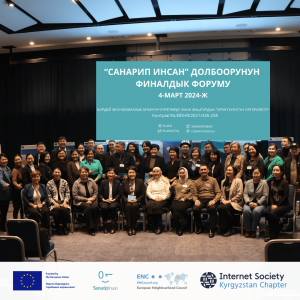
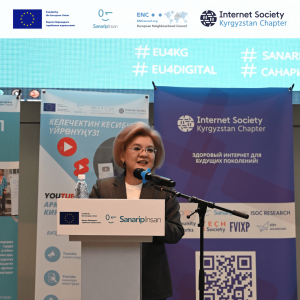
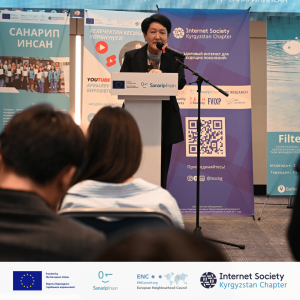
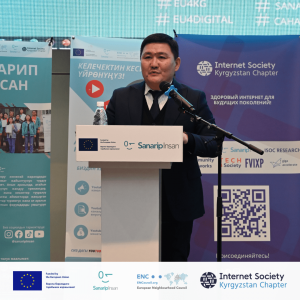
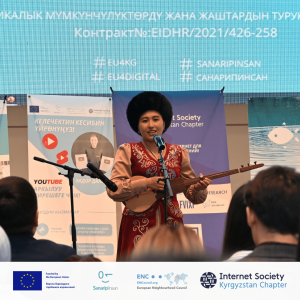

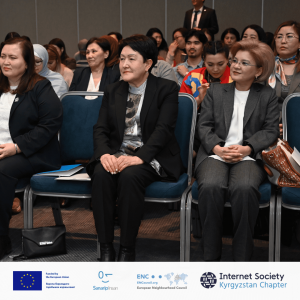
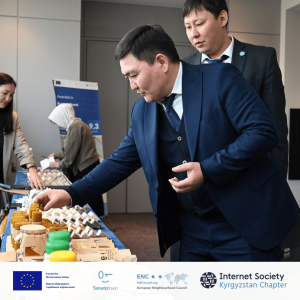
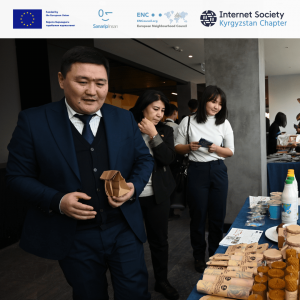
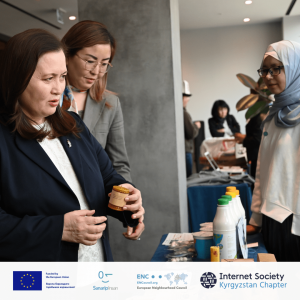
The project “Sanarip Insan,” implemented with the financial support of the European Union, the European Neighborhood Council, and the Internet Society Kyrgyz Chapter (ISOC), is paving the way for inclusive growth and innovation in Central Asia. The main goal of the project is to promote equal economic opportunities and the resilience of youth and women in rural regions of Kyrgyzstan to improve economic prosperity through digital platform training and increased digital literacy. The project’s activities have resulted in improved indicators of youth security regarding Sustainable Development Goals and human rights protection.
Focusing on three key areas—e-commerce, digital tourism, and digital agriculture—the “Sanarip Insan” has helped residents of the region’s villagers themselves with digital knowledge, which has increased their economic well-being and contributed to sustainable development.
On March 4th, the final forum of the “Sanarip Insan” project took place.
“The project’s main focus is on the regions, and it seems to us that there are very few opportunities for digital skills in the regions, and even fewer opportunities are available for women and youth. We believe that by expanding their economic and digital opportunities, the regions will develop rapidly,” emphasized Talant Sultanov, director and co-founder of ISOC Kyrgyzstan.
In line with the priorities of the Kyrgyz government for digitalization, the project is being implemented in close coordination with various ministries and agencies. Joint efforts with the Ministry of Education have led to the development of digital educational materials, and partnerships with the Ministry of Digital Development and the Ministry of Culture, Information, Sports and Youth Policy ensure a comprehensive approach to expanding digital opportunities.
“The ‘Sanarip Insan’ project is being implemented for two years. Today, here, we have such a rich exhibition of products that have been implemented thanks to this project. Digital skills have been improved, business skills have been enhanced, and the qualifications of employees of various projects have been raised. All this is thanks to this project, so we are very pleased that projects like ‘Sanarip Insan’ exist,” emphasized Nuriya Kutnaeva, Minister of Digital Development.
To enhance computer literacy, one of the frameworks for digital competencies, Microsoft Digital Literacy, has been fully adapted and voiced in the Kyrgyz language. Around 100 video materials and an equal number of presentation materials for teachers are available in the Kyrgyz language.
“Sanarip Insan” has taken the first step in making programming languages accessible in the Kyrgyz language by translating the Python programming language, which is now available to every Kyrgyzstani.
“The Python programming language has been translated into the Kyrgyz language. 76 video lessons have been created, which we have distributed to 2,300 schools across the country. Now students in the regions interested in IT technologies can learn independently. Our goal for this year is to provide graduates with a certificate in digital knowledge,” said Supanalyev Bekzhan, Deputy Minister of Education and Science of the Kyrgyz Republic, at the forum’s opening.
One of the main achievements of the project was a startup competition for youth with a total prize fund of 2.7 million soms (27,500 euros). Thus, support was provided to 10 digital startups from all regions of the country. 255 jobs were created as a result of startup acceleration and financing.
Digital tourism and e-commerce were important components of the project. Within this framework, two-day courses were held in all seven regions of Kyrgyzstan, training 500 people who were able to create 356 jobs, 11 times more than planned. To improve digital literacy among the population, the project, in partnership with the GSMA Foundation, translated the Mobile Internet Skills Training Toolkit (MISTT) into Russian and Kyrgyz. Videos on the benefits of using digital platforms were shown on national and regional television channels—KTRK, ElTR—reaching an audience of 2.5 million people, with over 6 million video views and 6 million podcast listens throughout the project implementation period.
The project has helped thousands of citizens improve their digital skills, thereby enhancing their economic well-being, which will bring inclusive economic growth to the villages of Kyrgyzstan, ultimately affecting the country’s digital economy.
Outcomes by March 2024
- 500 women and youth from rural regions have been trained in digital tourism, e-commerce, and the use of new digital skills to open and run businesses with minimal capital. As a result of the training, 201 new jobs have been created
- The Microsoft Digital Literacy framework for digital competencies was translated and voiced into Kyrgyz, comprising 100 video materials and 100 presentation materials for teachers. 25 out of 50 universities have incorporated these materials into their curricula, benefiting 150,000 students who are enhancing their intermediate digital competencies
- In partnership with the GSMA Foundation, the MISTT mobile literacy training was translated into Russian and Kyrgyz, localized, printed into physical textbooks, made available electronically, and distributed via TV and radio. The total audience reached 2.5 million viewers
- The Python programming language was translated into Kyrgyz, and 74 videos providing practical guidance were created. These resources are available online on four digital platforms and have been installed on 2000 educational laptops distributed by the Center for Civic Education throughout the country. The course has reached an audience of 150,000 students and 10,000 teachers
- The distribution of materials was disseminated among 84 local governments, including two cities of republican significance, 12 cities of regional significance, 17 cities of district significance, and 453 aiyl aimaks
- The project supported a youth startup competition, with 160 applications submitted. Twenty-two of these passed through an acceleration program, and finally, 10 projects received financial support totaling 2.7 million soms. As a result, 255 new jobs were created
- In support of the SDG concept, the project developed a course on innovative green economy for universities. 30 teachers and 394 students were trained in this course, which has been integrated as a modular course
- The cumulative audience for 2 years: videos on digital platforms – 2,552,507 viewers; podcasts on national and regional – 6,584,000; regional TV – 78,152 viewers, national TV – 6,106,740; online media – 6,492,716; social media – 4,723,163.

